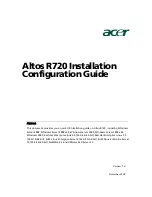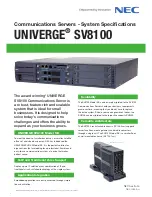
Chapter 5: Technical Configuration
About Service Records
An SRV record holds the following information:
•
Service
: the symbolic name of the desired service.
•
Protocol
: this is usually either TCP or UDP.
•
Domain name
: the domain for which this record is valid.
•
TTL
: standard DNS time to live field.
•
Class
: standard DNS class field (this is always
IN
).
•
Priority
: the priority of the target host.
•
Weight
: A relative weight for records with the same priority.
•
Port
: the TCP or UDP port on which the service is to be found.
•
Target
: the hostname of the machine providing the service.
An example SRV record might look like this:
_sip._tcp.example.com 86400 IN SRV 0 5 5060 sipserver.example.com.
This expression denotes a server named sipserver.example.com. This server listens on TCP port 5060 for SIP protocol
connections. The priority given here is 0, and the weight is 5.
7. Set up the Web Browser GUI (Optional). After an IP address for the TalkAnytime unit has been
established, you can choose to do any further configuration of the unit (a) by using the TalkAnytime web
browser GUI, or (b) by continuing to use the TalkAnytime Windows GUI. If you want to do configuration
work using the web browser GUI, you must first set it up. To do so, follow the steps below.
A. Set IP address of TalkAnytime unit using the TalkAnytime Configuration program (the Windows
GUI).
B. Save Setup in Windows GUI.
C. Close Windows GUI.
D. Install Java program from TalkAnytime product CD (on first use only).
E. Open web browser.
F. Browse to IP address of TalkAnytime unit.
G. If username and password have been established, enter them when when prompted.
H. Set browser to allow pop-ups at least for the IP address at which the TalkAnytime unit is located. The
TalkAnytime Web GUI makes extensive use of pop-up windows to access screens and commands.
I. Use web browser GUI to configure or operate TalkAnytime unit. The configuration screens in the web
browser GUI will have the same content as their counterparts in the Windows GUI; only the graphic
presentation will be different.
For more details on enabling the TalkAnytime web GUI, see the “Web Browser Interface” section of the
Operation & Maintenance chapter of this manual.
Multi-Tech Systems, Inc.
TalkAnyTime User Guide
71
Summary of Contents for TalkAnytime TA410
Page 6: ...Chapter 1 Overview Multi Tech Systems Inc TalkAnyTime User Guide 6 ...
Page 15: ...Multi Tech Systems Inc TalkAnyTime User Guide 15 Chapter 2 Quick Start Instructions ...
Page 51: ...Chapter 4 Software Installation Multi Tech Systems Inc TalkAnyTime User Guide 51 ...
Page 58: ...Chapter 5 Technical Configuration Multi Tech Systems Inc TalkAnyTime User Guide 58 ...
Page 100: ...Chapter 5 Technical Configuration Multi Tech Systems Inc TalkAnyTime User Guide 100 ...
Page 107: ...Chapter 6 Phonebook and URL Configuration Multi Tech Systems Inc TalkAnyTime User Guide 107 ...
Page 129: ...Chapter 7 Operation and Maintenance Multi Tech Systems Inc TalkAnyTime User Guide 129 ...
Page 184: ...Chapter 8 Warranty Service and Tech Support Multi Tech Systems Inc TalkAnyTime User Guide 184 ...
Page 187: ...Chapter 9 Regulatory Information Multi Tech Systems Inc TalkAnyTime User Guide 187 ...
Page 193: ...Appendix A Cable Pinouts Multi Tech Systems Inc TalkAnyTime User Guide 193 ...
Page 196: ...Appendix B TCP UDP Port Assignments Multi Tech Systems Inc TalkAnyTime User Guide 196 ...
Page 198: ...Index Multi Tech Systems Inc TalkAnyTime User Guide 198 ...
Page 209: ...S000388B ...
















































